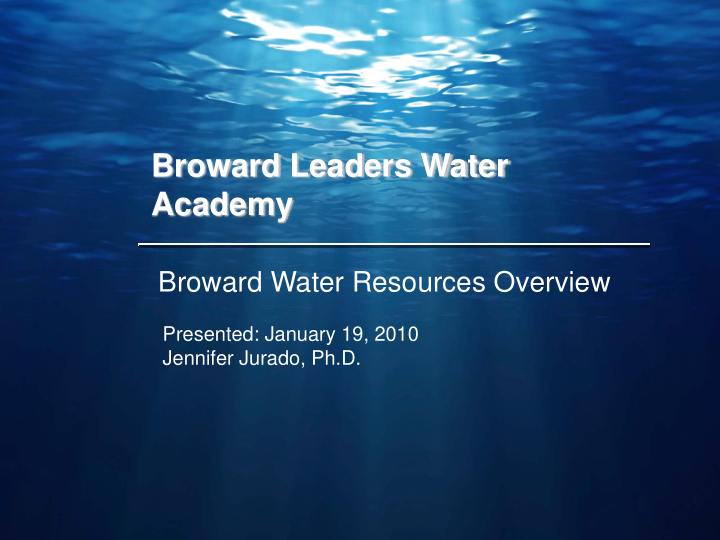



Broward Leaders Water Academy Broward Water Resources Overview Presented: January 19, 2010 Jennifer Jurado, Ph.D.
Broward – Rich in Water Resources
Broward and the Everglades
Land Use and Water Management Broward County Historical Commission SFWMD
Long ‐ term Growth Trends Today: • Population of 1.67M •18 th most populous county in U.S. •Projected 25% increase by 2030 • One of fastest growing counties numerically
The Biscayne Aquifer
Characteristics • Coastal Aquifer • Human ‐ induced Stresses: 5cm – Everglades drainage – Well field pumping – Canal water level management – Agricultural/Urban development • Natural Stresses: – Sea level rise – Rainfall variations
Aquifer Recharge • Rainfall • Surface deliveries • Groundwater seepage
Waves of Policy Change • 2000 – CERP is adopted for Everglades restoration • 2000 ‐ Census reveals significant population growth • 2000 ‐ 2001 –Regional drought and water shortage Restrictions 80 Restrictions 70 Broward Lake O 60 Rainfall (inches) 50 40 30 20 10 0 1996 1997 1998 1999 2000 2001 2002 2003 2004 2005 2006 2007 2008 2009
Evolution of Water Policy • 2002 – Amendment to Growth Management Act • 2004 – Goal ‐ based Water Conservation • 2007 – Regional Water Availability Rule • 2008 – Ocean Outfall Legislation
Lake Okeechobee Considerations • A remote and occasional source of recharge • Variable water levels and uncertain availability
Lake Okeechobee • Water levels managed in accordance with a regulatory schedule. • Environmental needs • Water supply considerations Normal • Rainfall predictions • Concerns about dike dropped levels by 1 ft ‐ water supply storage • Affected by regional water shortages. Extreme Low • Infrequent water supply benefits.
Looking Beyond the Biscayne X Reuse 60%
Planning for Tomorrow • Water Provider 10 ‐ year Water Supply Facility Workplans • Broward County ‐ wide Integrated Water Resources Plan • Broward Water Resources Task Force
Water Supply Facility Workplans • Required of all local governments responsible for water supply • Objective ‐ provide greater coordination between future land use and water supply planning • Requirements – Assess demands and quantify needs – Commit to specific water supply projects – Identify and budget necessary funds
The Broward Integrated Water Resources Plan • Foundation for current and future county ‐ wide water resource planning and management activities: • Seek efficiencies through canal integration • Optimize use through water conservation • Achieve effective planning and management • Diversify water sources and projects
Surface Water Management • Natural systems • Wellfields • Saltwater Saltwater intrusion Front • Flood protection
Rehydration and Restoration Hillsboro Pineland ESL
Assessments and Planning • Development and application of technical tools: • Broward County hydrologic model • Saltwater intrusion model • Study of upper Floridan • Water Management Master Plan
The Case for Conservation • Provides the lowest cost source of future water • Postpones and reduces the need for more costly alternative water supplies • Lessens the severity of water shortages • Helps to maintain groundwater levels and protect existing water supplies • Will become increasingly important with climate change
Opportunities for Conservation Restrictions
Water Demand as a Function of Per Capita Consumption 400 3.00 2008 Update Low (134 gpd) 350 2.50 Medium (146 gpd) High (160 gpd) 300 Water Demand (mgd) Population (Millions) 2.00 250 200 1.50 150 1.00 100 0.50 50 0.00 0 2000 2005 2010 2015 2020 2025 2030 Year
Water Conservation Initiatives • Annual Water Matters Day Event • NatureScape Broward Program • NatureScape Irrigation Service • Broward Schools Environmental Partnership • Broward Water Conservation and Incentives Program
Broward Water Matters Day
NatureScape Broward • 2,900 certified sites and 11 community partners
NatureScape Irrigation Service • 659 million gallons saved, average 18% reduction
Partnership with Broward Schools
Water Conservation and Incentives Program • Collaboration with 18 municipal and water utility partners • To include: – unique branding, – broad messaging, – rebates/incentives • Kick ‐ off in summer 2011
Broward Water Resources Task Force • 15-member Task Force • Convened to evaluate regional water supply options and water conservation strategies • September 2010 report includes 40 recommendations: – Water conservation – Regional project concepts – Reuse development – Research and Investigations • Several prominent recommendations are already advancing
The Challenges of Climate Change • Water resource implications for south Florida are expected to include: – More intense rain and storm events – Regional droughts – Rising sea level – Saltwater intrusion – Coastal and inland flooding
Adaptation Planning Activities • Variable density models are being developed to guide placement of water wells and operations • Partnership with the USGS will produce an adaptation planning model to address impacts on drainage and flood control • Technical assessments of Floridan Aquifer and modeling support diversification of water supplies needed to reduce impacts of water shortages
Climate Mitigation Efforts • Investments in conservation will serve to: – Reduce demands for high energy alternative water supplies – Lessen water shortages that may accompany drought – Maintain aquifer levels needed to abate saltwater intrusion
The Future • Sustainable solutions will require: • Greater conservation ethic • Partnerships in the pursuit of projects and funding • Participation of both public and private sectors • Integration of new technologies into business and governmental operations • Commitments
Questions?
Recommend
More recommend